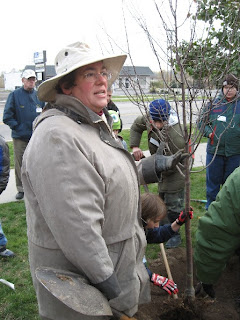
 Pictured above: Boy Scouts clearing dirt from a hole in front of the public library and Rochelle Smith instructing volunteers on the how to plant a happy, healthy tree.
Pictured above: Boy Scouts clearing dirt from a hole in front of the public library and Rochelle Smith instructing volunteers on the how to plant a happy, healthy tree.
Before any of the volunteers got started in their activities, Rochelle Smith demonstrated the proper technique of planting a tree. Everyone crowded around her, and she asked for Boy Scouts to help her. The young men were very eager to volunteer and it wasn’t long before Rochelle was surrounded by enthusiastic Boy Scouts with shovels.
She repeated the demonstration twice so that people at each of the two sites (Town Commons Park and Veterans Park) could get the benefit of the instruction.
Rochelle and a group of Boy Scouts started the demonstration by showing a hole in the ground that town employees using a stump grinder had dug in advance of the event. Besides the hole, there was nothing in the spot but a small white flag. That little flag was used to match with a little tag on the tree. That ensured that the right tree was planted in the spot. Rochelle explained that each of the sixty trees that were to be planted “were chosen because they met the site requirements. They were the right size and shape. They were chosen because they could withstand the soil and, if they were close to the road, they could withstand the salt” used on the road during the winter.
During training sessions that were held in town hall in advance of the tree plantings, Rochelle said that trees had to be carefully chosen for the places where they were to be planted. Things such as location and soil conditions were very important considerations. If a tree that tended to drop a lot of fruit were planted close to the road, that might not be a good thing. People generally do not tend to appreciate their cars getting bonked with over ripe fruit while they are out for a drive. Pedestrians also do not appreciate getting beaned by over ripe fruit while out for leisurely stroll. There is something about an attack tree that does not encourage relaxation and leisure. I for one do not car to have the experience that Dorothy did in The Wizard of Oz when her picking apples caused the apple tree to yell at her and her three companions and to start throwing apples at them. But, I digress (my best skill!). Anyway, in Grand Island, the condition of the soil is also something that has to be considered in choosing trees. Grand Island’s soil contains a large amount of heavy clay. Some hardy tree species do well in this type of soil. Other trees need a different type of top soil.
There is a definite technique to planting a small tree that will grow up to be a big, strong, and happy tree, able to give shade and to replace the oxygen that we use just by breathing. Rochelle mentioned several things that tree planters needed to look for to make sure the tree that they planted had a good start in life. One was to check that the hole was the right size so that the tree would fit comfortably without damage to its roots. That could be done by laying the shovel over the top of the hole, with the tree standing in it. If the “root flare” (The widest part of the trunk that is closest to the root system) is standing above the hole, then the hole is too shallow. If the root flare is lost in the hole, then the hole is too deep and some of the dirt needs to be put back into the hole. If the root flare is even with the shovel handle, then the tree is in the right position to be planted. The second thing to check is to make sure that no part of the root system is left bare. If the root is not in direct contact with the soil, it gets no water, and the tree could die. Rochelle emphasized that volunteers make sure that the tree is straight. After all, we don’t want any trees to resemble the Leaning Tower of Pisa! “We want this tree to stand up by itself,” she said.
Rochelle also emphasized that it is necessary to consider the tree’s appearance from the viewer’s perspective. “Some trees aren’t going to have branches all of the way around. You want the pretty side to be toward the viewer. So look at your space.” Once the tree is planted and the pretty side is facing the street or the walking path, stakes are placed in the ground, and the young tree is tied to the stakes. Those stakes stay in the ground for two winters, until the tree has grown strong enough to stand on its own.
With that, the volunteers were turned loose to plant their own trees!!